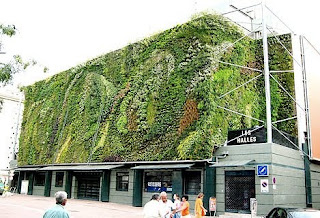
The Rise of Vertical Gardens: A Sustainable Solution for Modern Design
Introduction
Vertical gardens, also known as green walls or living walls, have gained significant attention in recent years due to their relevance in sustainable design. These innovative structures allow for the cultivation of plants vertically on building facades or other vertical surfaces. This article explores the importance of vertical gardens in addressing environmental concerns and promoting sustainable living.
Historical Background
Vertical gardens have a rich history that dates back to ancient civilizations. The Hanging Gardens of Babylon is a prime example of early vertical gardening. Over time, the concept has evolved, and today, vertical gardens play a pivotal role in modern sustainable design.
Key Concepts and Definitions
Vertical gardens differ from traditional gardens as they utilize vertical spaces to grow plants, making efficient use of limited land. Sustainable design focuses on creating environmentally-friendly and socially-responsible structures. Vertical gardens seamlessly integrate within sustainable design principles, contributing to a healthier and greener environment.
Main Discussion Points
Environmental Benefits of Vertical Gardens
Vertical gardens play a vital role in addressing environmental concerns. Firstly, they contribute to air purification by absorbing carbon dioxide and releasing oxygen. Additionally, these green walls act as natural sound barriers, reducing noise pollution in urban environments. Furthermore, vertical gardens help combat the urban heat island effect by providing shade and cooling effects, ultimately improving energy efficiency. They also aid in water management by reducing stormwater runoff, preventing flooding, and promoting water conservation.
Social and Health Benefits of Vertical Gardens
Vertical gardens have significant social and health benefits. By providing access to green spaces, they enhance the overall well-being of individuals. These green walls offer a refreshing and calming atmosphere, promoting relaxation and stress reduction. The presence of greenery in urban areas also helps improve the mental health of residents, contributing to a healthier and happier community.
Economic Benefits of Vertical Gardens
In addition to environmental and social benefits, vertical gardens offer economic advantages. By improving building energy efficiency, they help reduce energy costs for both residential and commercial properties. Vertical gardens also have the potential to increase property value, attracting tenants or customers due to their aesthetically pleasing and sustainable features.
Case Studies or Examples
Successful implementation of vertical gardens in sustainable design projects has been witnessed globally. One notable example is the Green Ribbon project in Singapore, where vertical gardens are integrated into the architecture of buildings, creating a lush and sustainable cityscape. These case studies highlight the positive outcomes and benefits of vertical gardens, proving their effectiveness in enhancing sustainable design.
Current Trends or Developments
Recent trends in vertical gardens include the use of hydroponic systems, which allow plants to grow without soil, maximizing space utilization. Green walls are also gaining popularity as they can be easily installed and maintained. Ongoing research and technological advancements are focused on improving irrigation systems, optimizing plant choices, and developing sustainable materials for vertical gardening structures.
Challenges or Controversies
Implementing vertical gardens comes with certain challenges. Maintenance requirements, such as watering, pruning, and pest control, can be demanding and time-consuming. Structural considerations, such as the weight of the green wall and its impact on building stability, need to be carefully addressed. Controversies exist regarding the long-term viability and effectiveness of vertical gardens, with some arguing that the initial costs and maintenance outweigh the benefits.
Future Outlook
The future of vertical gardens in sustainable design practices looks promising. As awareness of environmental issues grows, so does the demand for greener and more sustainable solutions. Advancements in technology and research will likely lead to more efficient and cost-effective vertical gardening systems. Vertical gardens have the potential to become a standard feature in urban environments, contributing to a more sustainable and visually appealing future.
Conclusion
Vertical gardens have emerged as a sustainable solution for modern design, addressing environmental concerns while enhancing the well-being of individuals. They offer numerous benefits, including air purification, noise reduction, improved energy efficiency, and increased property value. By integrating vertical gardens into sustainable design practices, we can create greener and healthier communities for the future.